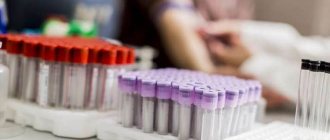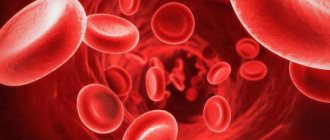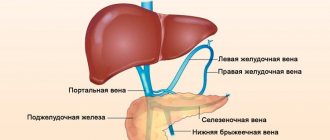Almost any problem in the human body affects the composition of the blood, so its biochemical analysis serves as the basis for diagnosis. As a result, many patients are interested in ALT and AST levels. Liver enzyme tests are the most important method for detecting severe liver diseases.
CONSULTATION ON THE RESULTS OF ANALYSIS AND ULTRASOUND — 500 rubles. (at the patient's request)
CLICK TO SIGN UP
These substances are representatives of the enzyme group, which normally have low levels in the blood. In diseases accompanied by cell destruction, the indicators of these enzymes in analyzes increase several times and even tens of times, which confirms the presence of a pathological process.
Description
AST catalyzes the transamination reaction, which results in the conversion of oxaloacetate (oxaloacetic acid, OA) to aspartic acid (aspartate) by transferring an amino group to the OA molecule. The second product of the reaction is α-ketoglutaric acid (α-ketoglutarate), one of the intermediate products of the tricarboxylic acid cycle. The reaction plays an important role in the process of releasing ammonia from amino acids. The ammonia is then processed in the urea cycle, since the aspartate obtained during the reaction is needed to form argininosuccinate. In addition, in the process of reverse reaction, aspartate is converted into oxaloacetate. Thus, this reaction is of great importance in the processes of gluconeogenesis. For diagnostic purposes, determination of AST activity is usually carried out in conjunction with determination of the activity of another aminotransferase, alanine aminotransferase (ALT, ALT). Both enzymes are present in cells of various tissues, but ALT is present in significant quantities only in liver tissue. In myocardial tissue and skeletal muscles, the amount of AST is 20 times higher than the level of ALT. Sometimes very high AST activity is observed, which can exceed the normal limit by 100 times. This occurs in diseases associated with severe tissue damage - acute hepatitis, compartment syndrome, tissue hypoxia. In case of hepatitis, AST readings exceed the norm by 10–20 times and this occurs during the prodromal stage (at the time of the appearance of jaundice or shortly before that). During myocardial infarction, AST activity increases after 12 hours. The peak of activity occurs 24–36 hours after a heart attack and is 10 times higher than normal. Then the indicators decrease within two to three days, which is evidence of the absence of damage to the heart muscle.
In most diseases associated with an increase in AST concentration, there is a simultaneous, although less high, increase in ALT concentration. However, with hepatitis, the activity of ALT in the blood plasma may exceed the activity of AST. AST concentration is often measured as part of a “biochemical profile.” AST concentrations exceeding the upper limit of normal by more than 20 times are most often observed in the prodromal stage of viral hepatitis. A doubling of concentrations is sometimes observed in the absence of clinical symptoms of tissue damage. The cause in this case is most often alcohol abuse. This enzyme does not have tissue-specific isoforms, and if no other biochemical abnormalities are found and no obvious reasons for such an increase, then the analysis should be repeated after 2-3 weeks.
Importance of liver enzymes
The content of the article
A separate class of enzymes are transferases, catalysts for the transfer of molecular residues and functional groups from molecule to molecule.
Transferases are involved in the transformation of nucleic acids and amino acids, lipids and carbohydrates. The most significant liver enzymes are considered to be ALT and AST, which perform several tasks at once.
- Molecular intracellular synthesis ensures sufficient liver functionality.
- Enzymatic diagnostics, carried out by measuring the degree of enzyme activity in the blood. The reliability of this method is based on the fact that liver enzymes in a healthy person are contained inside the cell, leaving it only after the death of the cell itself.
- The prognostic role of enzymes is associated with the characteristics of their dynamics in the blood, which directly depends on the nature of the course and severity of the disease.
- The medicinal role of enzymes is to use special enzyme preparations when they are deficient in the body.
Peptides in blood tests
One of the convenient options for checking blood biochemistry for normal values is the corresponding table. If the C-peptide is higher, then there is a suspicion of excessive insulin synthesis, the development of tumor formation or pancreatitis. A decrease compared to the standard may occur, this is possible during inflammation or diabetes (only the first type).
Content of glucose and carbohydrate metabolism metabolites
In diabetes mellitus, glucose increases, other reasons: problems with the central nervous system, pituitary gland, thyroid gland, brain injuries. If normal blood biochemistry levels for glucose in adults are underestimated, it is worth checking the endocrine system, liver and pancreas.
Features of ALT norms in pregnant women
In a healthy woman, the ALT norm does not change during pregnancy and should coincide with the values before conception. In cases where ALT is slightly increased during pregnancy, causes not related to diseases can be considered:
- course of intramuscular injections;
- physical activity that is excessive for a pregnant woman;
- addiction to fast food;
- uncontrolled intake of dietary supplements;
- obesity;
- fetal pressure on the biliary tract, preventing the outflow of bile.
Normalization of nutrition, moderation of physical activity, weight control and choleretic drugs normalize enzyme parameters.
Amino acids and proteins
Protein often decreases during fasting or when following diets, but it can indicate a number of pathologies: chronic bleeding, problems with metabolic processes, anemia. Underestimated data is the norm during breastfeeding, during pregnancy (late pregnancy), for bedridden patients or in case of significant physical exertion.
The interpretation of the tests taken during blood biochemistry is considered carefully and normal values should not be exceeded. The protein is present in excessive amounts in individuals with autoimmune diseases, during infections, in cases of significant kidney pathologies or in the presence of malignant tumors.
Reduced levels of amino acids are a bad indicator, observed when there are problems in metabolic processes, often resulting in kidney or liver problems.
Who is prescribed an ALT test?
An ALT test is prescribed in the presence of certain symptoms and factors:
Symptoms of liver disease:
- weakness, lack of appetite, nausea and vomiting;
- abdominal pain, jaundice;
- dark urine and light-colored feces.
Risk factors for liver disease:
- previous hepatitis,
- alcohol addiction,
- diabetes and obesity,
- hereditary reasons
- taking medications that have an aggressive effect on the liver.
ALT blood test is carried out for the following purposes:
- checking for possible liver damage due to injury;
- identification of drug and alcohol addiction within the framework of a set of interrelated indicators;
- assessment of the effect of anticholesterol therapy and a number of other drugs that are relatively toxic to the liver;
- Finding out the cause of jaundice in a patient - liver disease or blood dysfunction.
A patient who is prescribed an ALT test should inform his doctor about the presence of reasons that could reduce the accuracy of the test results:
- taking certain medications, dietary supplements and herbal infusions (oral contraceptives and aspirin, warfarin and paracetamol, infusions of valerian and echinacea);
- possible pregnancy;
- presence of allergies;
- completing a course of intramuscular injections;
- rehabilitation period after cardiac surgery or cardiac catheterization;
- active physical activity before the test.
The test is performed on the patient's venous blood and results can be available in approximately 12 hours.
How to prepare for donating blood for “biochemistry”?
In order for the results to be as accurate as possible, you must follow the rules for preparing for a blood test for a biochemical study:
- Within two days, switch to a gentle diet - eliminate fatty, sweet, spicy, salty, smoked foods, and also give up alcohol, coffee and strong tea;
- The day before, refrain from any stressful procedures and activities for the body - baths and saunas, contrast showers, heavy physical activity;
- If you are taking medications, discuss with your doctor whether they will affect the test results;
- 6-12 hours before the BAC, you should not eat any food or smoke. You are only allowed to drink plain water.
Dependence of ALT level on age and other indicators
During a person's life, the level of ALaT changes. You need to know this in order to correctly decipher ALT in a biochemical blood test.
- In healthy full-term newborns, the alanine aminotransferase rate ranges from 10 to 17 U/l.
- If the baby was born prematurely, then this figure can be 13–26 U/l, and the level of this substance in the blood of such babies changes almost daily.
- From the sixth day of life to six months of age, the upper limit of alanine aminotransferase increases slightly and amounts to 30 U/l. This is explained by the fact that in the first six months all biochemical mechanisms are gradually “launched” in the baby’s body, because the child adapts to existence outside the mother’s womb.
- From seven months to a year, this figure fluctuates between 13–29 U/l. At this time, the indicators for boys and girls do not yet differ.
- From one year to 14 years, the concentration of alanine aminotransferase in boys and girls is different. Moreover, in the female body it will be lower than in the male body. For girls of preschool age, the norm will be considered a concentration of 13–18 U/l, and for boys the upper limit is already 22 U/l. This trend will continue throughout your life.
Alanine aminotransferase levels in adults
- Before reaching the age of 60, the normal alanine aminotransferase level in men is 10–45 U/L, while the normal ALT level in women during this period is only 10–31 U/L.
- The level of this substance in the blood can only change during pregnancy, and then not in all women. In some cases it remains unchanged. If the expectant mother's ALT level is slightly elevated and is 35 U/L, this is not a cause for concern. An increase in ALT during pregnancy is caused by the fact that the enlarged uterus may slightly compress the bile ducts or a slight bend has appeared in the bile ducts. There is no need to be afraid of this state of affairs - after childbirth, the uterus will shrink and the indicators will return to normal. However, if the increase in ALaT in the blood during pregnancy continues, and the concentration of this substance reaches high levels, additional examinations should be performed, as this may be associated with impaired functioning of the liver, kidneys and heart.
- When people “step over” the 60-year barrier, the level of alanine aminotransferase in the blood also changes. Normally, ALT in men of this age ranges from 10 to 40 U/l, and for females it will be 10–28 U/l. The concentration of alanine aminotransferase remains at this level until the end of life.
However, a normal blood level of this substance does not always indicate that a person is healthy. In some cases, even with severe pathology of the liver and kidneys, the indicator does not change, especially for the fairer sex. That is why an isolated study of the concentration of this enzyme in the blood is very rarely prescribed. Most often, other biochemical indicators are analyzed in parallel, which allows a much more accurate understanding of the state of the body.
Why is an ALT test done?
The endogenous enzyme ALT serves as a reliable marker of liver tests - liver pathologies in diagnostic laboratory practice. Alanine aminotransferase is formed due to intracellular synthesis, so it is present in the blood in small doses.
Blood test for ALT
in a healthy person it shows a minimum value. Diseases or damage to the liver cause the death of its cells, and the intracellular liver enzyme ALT is released into the blood, which, along with other indicators, is a fairly informative indicator of disease processes. Any deviation of the enzyme indicator from the standard range, especially upward, is an indisputable sign of an incipient liver disease or an extensive process of its destruction
Elevated ALT levels may also be observed in pregnant women, during a heart attack, and in certain pathological conditions. An increase in the dose of ALT in the blood is observed before the manifestations of jaundice, which allows for early diagnosis of liver diseases.
What is alanine aminotransferase (ALAT)
The functioning of the human body is ensured by multiple chemical processes that are both cyclical and interconnected, continuous and consistent. Enzymes play a major role in blood filtration and digestion systems. Alanine aminotransferase (ALAT) is the main liver enzyme involved in amino acid metabolism. Most of the enzyme is found in the liver, with small amounts in the kidneys, cardiac and skeletal muscles.
Alanine itself is important as a source of rapid glucose production to nourish the brain and central nervous system. Studying the level of ALT and AST in the blood greatly facilitates the diagnosis and prognosis of severe diseases and damage to the liver, heart and pancreas.
The specificity of ALT makes it possible to differentiate diseases according to the degree of excess of standard values, which is very important when symptoms are weak and the manifestations of various diseases are similar. Using ALT readings in combination with other tests, the doctor can determine the extent of organ damage and make a prognosis for the course of the disease.
ALT elevation levels
The standard ALT indicator as part of the diagnostic complex “blood biochemistry” may differ slightly in different laboratories, but on average the limits of this indicator for men are 10–40 U/l, for women – from 7 to 35 U/l. The criteria for differentiating diseases are levels of excess of the ALT norm:
Minor:
- taking medications and chemicals (antibiotics and barbiturates, chemotherapy and drugs),
- cirrhosis of the liver,
- fatty liver disease;
Moderate and medium:
- alcohol poisoning,
- some forms of hepatitis,
- growth problems in adolescents;
High:
- cancer tumor necrosis,
- viral hepatitis,
- state of shock.










